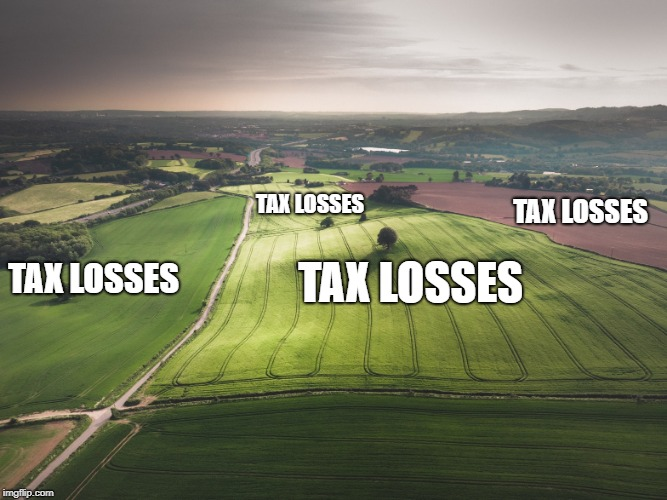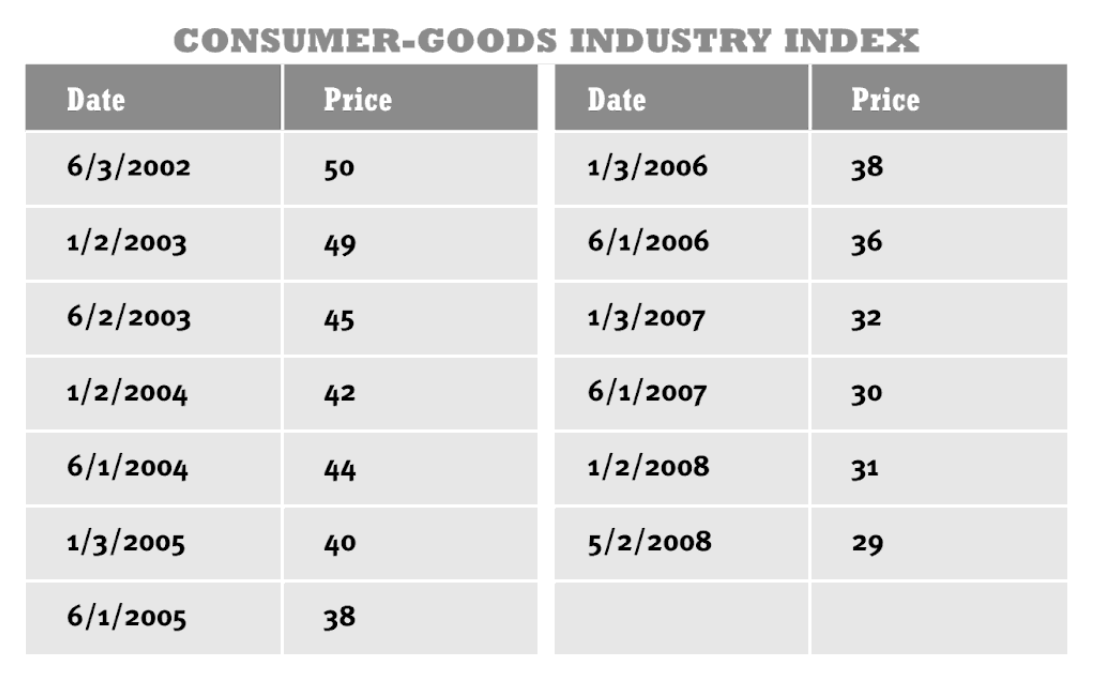Some farmers harvest corn. Others: wheat. Still, others: Maybe soybean.
And then there are those who harvest their losses on investments.

Ahhhhh! My beautiful acreage ready to be harvested.
Tax-loss harvesting happens when you sell an investment that’s experienced a loss in order to offset taxes on your capital gains and income.
That’s right. It’s buying high and selling low (aka the exact opposite of common sense and decency).
Of course, there’s a bit more to it than that. Let’s break down exactly what it means, how to do it, and whether it’s right for you.
But first, a quick lesson on everyone’s favorite topic: Capital gains and losses.
How capital gains and losses work
At the crux of tax-loss harvesting are capital gains and losses.
When you purchase an investment, that investment will either go up or down according to the market. Depending on when you sell that investment, you’ll experience one of two things:
- Capital gains. When an investment you sell is worth more than the price you bought it for (think: a hot Silicon Valley IPO that you buy at $20/share and sell at $35/share. Good job!).
- Capital loss. When an investment you sell is worth less than the price you bought it for (think: those Beanie Babies you bought in the ‘90s you were sure were going to make you rich).
The IRS divides the capital gains and losses into two categories.
- Short term. If you’ve held the investment for less than a year.
- Long term. If you’ve held the investment for more than a year.
Check out the chart below to find out how much your long-term gains stand to be taxed based on your income.
|
SINGLE TAXPAYER INCOME |
MARRIED JOINT FILING |
LONG-TERM CAPITAL GAINS TAX |
|
Up to $38,600 |
Up to $77,200 |
0% |
|
$38,600 – $425,800 |
$77,200 – $479,000 |
15% |
|
$425,800+ |
$479,000+ |
20% |
Capital losses (where you lose money on your investments) are also split into short term and long term. And when you sell an investment at a loss, you can use it to offset taxes on your capital gains — which brings us to …
What is tax-loss harvesting?
Tax-loss harvesting is when you sell off an investment at a loss and use your capital losses to lower the taxes that occur on your capital gains and income.
You then also purchase another investment that performs similarly to keep your portfolio balanced.
Say you bought $1,000 worth of shares in an index fund — and that share drops by $200. You can deduct that $200 from any taxes you get on your capital gains when you sell it.
Short-term losses are deducted from short-term gains and long-term losses are deducted from long-term gains.
But NET short- or long-term losses can be deducted from either category (this is the number you get after deductions).
Say you have $1,000 in short-term losses and $700 in short-term gains. You then have a net $300 short-term loss you can deduct from your net long-term gains tax within the same tax year.
If you end the year with a net capital loss overall, you can deduct as much as $3,000 from your income tax.
Here’s tax-loss harvesting in sum:
- Step 1: Experience a loss on your investment.
- Step 2: Sell that investment.
- Step 3: Deduct that loss from your capital gains and income tax.
- Step 4: Purchase a similarly performing investment.
There’s a catch with the last step: You need to be careful to avoid the Wash Sale Rule.
Beware: The Wash Sale Rule
The Wash Sale Rule is an IRS policy that says you can’t sell a security at a loss and purchase a “substantially identical stock or security” within 30 days before or after the sale (aka a “wash sale”). If you do, you won’t be able to deduct the losses on your capital gains or income tax.
From the IRS:
“You buy 100 shares of X stock for $1,000. You sell these shares for $750 and within 30 days from the sale you buy 100 shares of the same stock for $800. Because you bought substantially identical stock, you cannot deduct your loss of $250 on the sale.“
The same occurs if you purchase a different security that’s “substantially identical.” This can occur in cases in which the funds track the same indexes.
To get around this, someone who wants to do tax-loss harvesting should buy shares of a fund that performs similarly but tracks an entirely different index. Doing this will ensure your portfolio remains balanced but the IRS won’t consider your actions a wash sale.
Why you shouldn’t do this
My advice: Save your sanity and focus on more important things.
While tax-loss harvesting might seem like a good way to take advantage of losses to deduct from your taxes, I do not recommend it for most individual investors.
Say you invest in a stock for $100 and it drops to $90 over the tax year. You could go through the process of selling that stock, deducting the $10 loss, and getting a similarly performing security — but it’s so not worth it. That’s such a small win.
I rarely make specific stock investments, so I almost never have to sell investments.
Once you start making too much money to invest in your Roth IRA, you’ll need more help in this department. But for now, follow the old adage: “Don’t let Uncle Sam make your investment decisions.”
Plus if you build a well-diversified portfolio of index funds instead, you rarely have to think about selling.
But I know, shit happens. Sometimes you make a bad investment so something like tax-loss harvesting seems like a good idea. At that point, it might be a good idea to sell … which brings us to:
When to sell your stock
Imagine you pulled up your investments, and saw a stock underperforming for a while, would you sell it?
 Also imagine it was more than 10 years ago.
Also imagine it was more than 10 years ago.Answer: It depends. If this isn’t a regular occurrence and you believe that the market will recover (which it will), don’t sell. In fact, you might want to keep investing in that stock because it’s at a cheaper price.
You also need to take into account the context of the stock.
Ask yourself: How is the rest of the industry doing?

By looking at the stock and the surrounding industry, you can see that the entire industry is in decline. That’s not the fault of your investment necessarily. They’re all doing poorly. And all industries experience declines at one point or another.
So the stock is performing in line with the rest of the industry.
Of course, this now brings up the question of the industry. If you believe the industry is going through a cyclical downturn as many industries do, you should hang onto the shares and continue to invest.
However, if you think the industry won’t recover (e.g., you bought 1,000 shares in fidget spinner indexes) you might want to consider selling the investment.
The 85% solution to handling your taxes
Invest as much as possible into tax-deferred accounts like a 401k or Roth IRA.
Your 401k won’t be taxed until you withdraw it many years down the line, and your IRA earnings won’t be taxed at all.
You also won’t have to worry about the minutiae, including picking tax-efficient funds and utilizing methods like tax-loss harvesting. By taking the step of investing in tax-advantaged retirement accounts, you’ll sidestep the vast majority of tax concerns.
This is the 85% solution for your taxes. Sure, you can use tax-loss harvesting, use annual gift allowances to give thousands away to others in gifts, and leverage other complex tax structures — but how many of you actually need to do that?
Once you get 85% of the way there with your tax-deferred retirement accounts, you’re golden.
How you should invest instead
I highly recommend the average investor purchase lifecycle funds (or target-date funds).
These are funds that automatically diversify your investments for you based on your age. As you get older, they’ll adjust the asset allocation for you without you having to touch it.
For example, if you plan to retire in about 30 years, a good target date fund for you might be the Vanguard Target Retirement 2050 Fund (VFIFX). The 2050 represents the year in which you’ll likely retire.
Since 2050 is still a ways away, this fund will contain more risky investment such as stocks. However, as it gets closer and closer to 2050, the fund will automatically adjust to contain safer investments such as bonds, because you’re getting closer to retirement age.
These funds aren’t for everyone though. You might have a different level of risk or different goals. (At a certain point, you may want to choose individual index funds inside and outside of retirement accounts for tax advantages.)
However, they are designed for people who don’t want to mess around with rebalancing their portfolio at all. For you, the ease of use that comes with lifecycle funds might outweigh the loss of returns.
For more information on lifecycle funds, check out my three-minute video on the topic below.
Automate your way to a Rich Life
If you’re interested in building a healthy portfolio of investments and automating your system, I want to give you something that can help you start building that portfolio today.
In it, you’ll learn how to:
- Master your 401k: Take advantage of free money offered to you by your company … and get rich while doing it.
- Manage Roth IRAs: Start saving for retirement in a worthwhile long-term investment account.
- Spend the money you have — guilt-free: By leveraging the systems in this guide, you’ll learn exactly how you’ll be able to save money to spend without the guilt.
Enter your info below and get on your way to living a Rich Life today.
Tax-loss harvesting: How to offset your taxes is a post from: I Will Teach You To Be Rich.
No comments:
Post a Comment